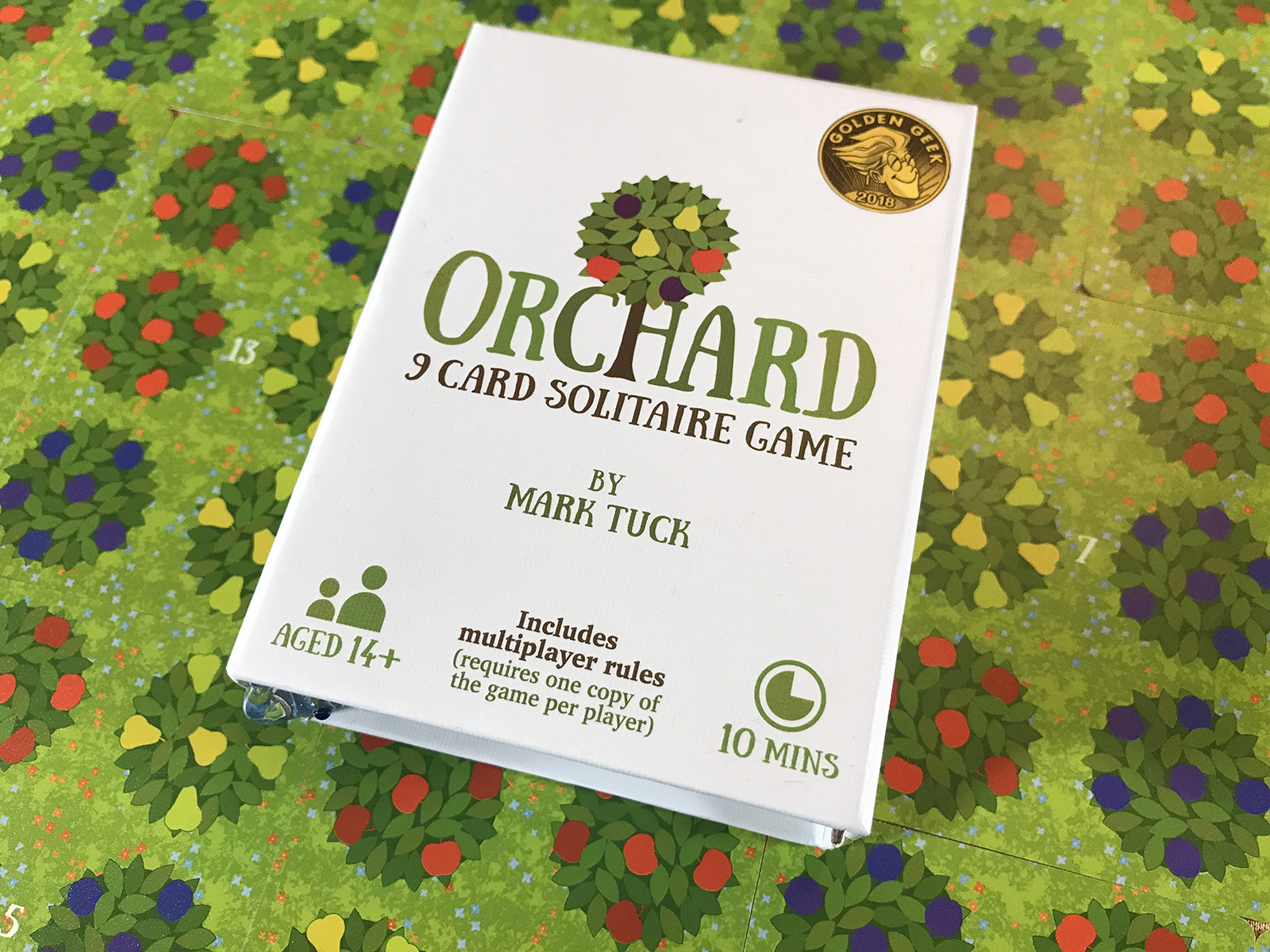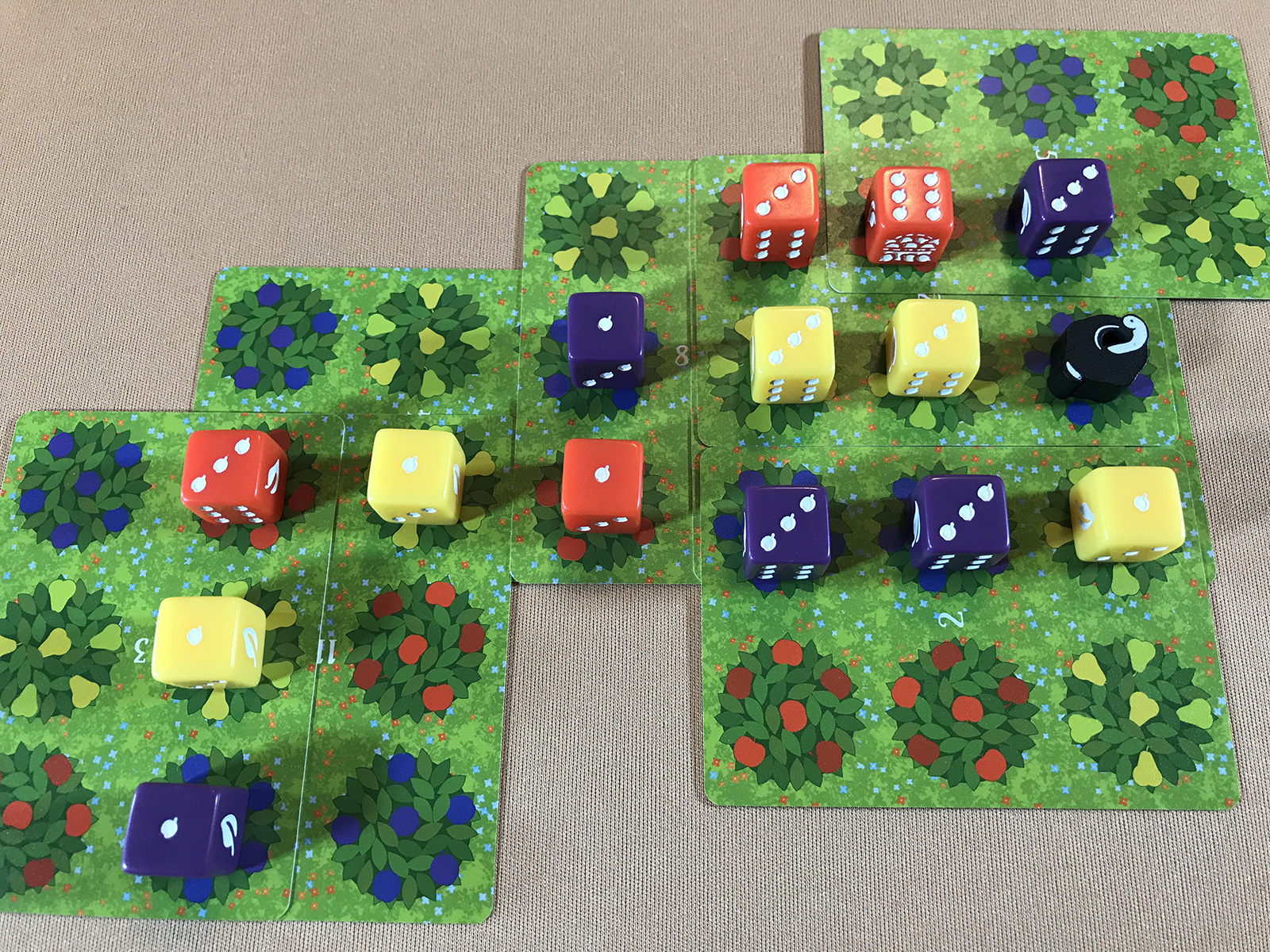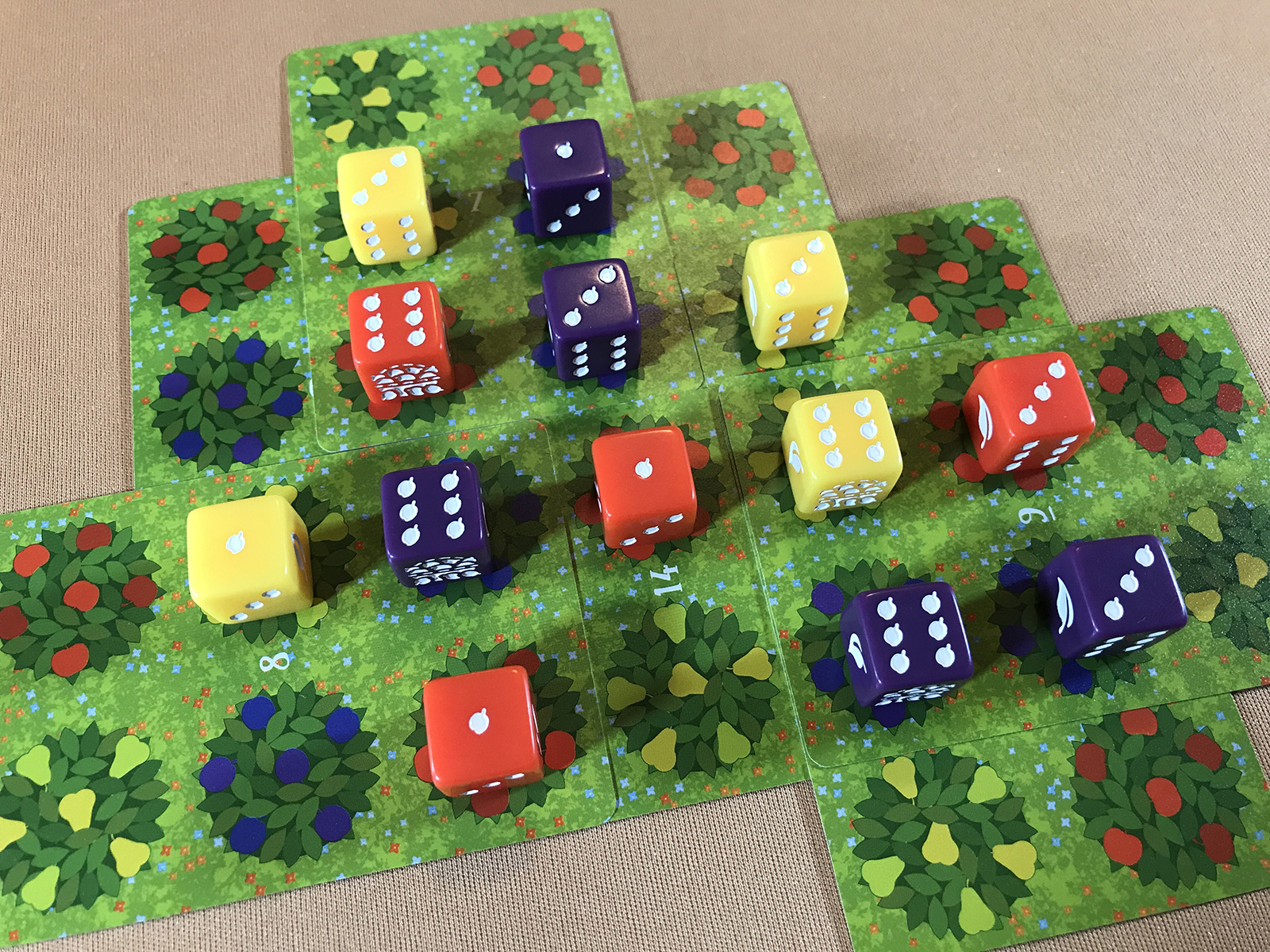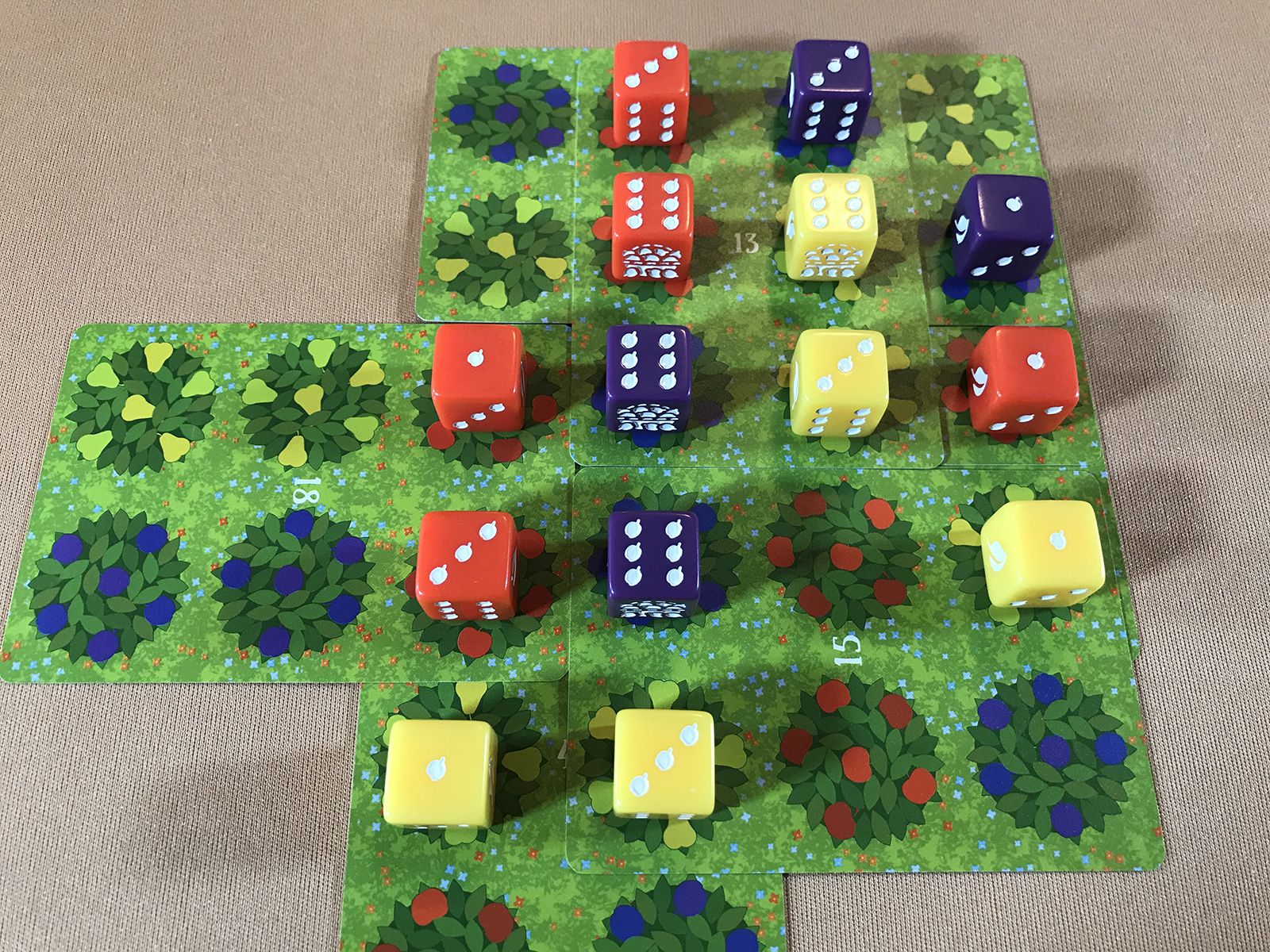An Annual Harvest with Orchard: A 9 Card Solitaire Game

Harvest a wonderful selection of apples, pears, and plums with the simple mechanics in Orchard: A 9 Card Solitaire Game.
Time to return to some of my favorite solo games! After spending most of 2022 focused on my unplayed games, I wanted to take a short break to appreciate a lot of my older games. Orchard: A 9 Card Solitaire Game went nearly a year without any attention. I couldn’t wait to see what I could do with a few cards and dice trackers: Harvest time!
Game Overview
Game Name: Orchard: A 9 Card Solitaire Game
Publication Year: 2018
Designer: Mark Tuck
Artist: Mark Tuck
Publisher: Side Room Games
Solo Mode: Designed for Solo (Included in the Base Game)
Identical trees overlap each other with cards, and dice act as simple trackers for final victory points. There are many decisions to make about how to place each card, along with the tempting option to use rotten fruit. Play is quick and simple to understand… But far from easy to master!
First Play
September 22, 2018
Complexity
1
Latest Play
August 3, 2024
Expansions
0
Setup Time
Almost None
Lifetime Plays
134
Play Time
5 Minutes
High Score
50
Game Area
12" x 12"
Low Score
18
By the Book
Despite it being close to a year since my last play, I didn’t have to open the rulebook. These rules were that easy!
That’s not an easy feat for any game, particularly with how many rulebooks I need to understand. So many solo games, and each one has its own specific parameters.
I loved being able to simply shuffle the cards and start to play without any questions. Rules confidence is important!
There was also something so cheerful about the trees, too, with their familiar patterns. The trick was to figure out how in the world I was going to score well, though. Ha!
A Valiant First Attempt
Maybe I had the rules memorized, yet my strategic choices weren’t quite there. My first couple of plays weren’t too bad, yet I also fell into the trap of using the worm token.
Rotten fruit occurs when different trees overlap in a spot. It can be helpful to boost nearby dice, yet it’s a choice that should be used very sparingly. But that worm is cute!
I’m actually still playing with the original rules, so the basket worth 10 points isn’t possible in my games. Yet.
All I needed to do was hit… 55 victory points. Could I do it? It was a fun challenge that had been ongoing for years!
Trick or Treat Popcorn
Well, hello there! All that fruit required a lot of carting about, and my popcorn tricycle was there to save the day.
Look closely, and you might discover an interesting piece of information about the popcorn. No worries: It wasn’t actually rotten, but tended to by some friendly worms!
I promised more Calico Critter photos! The driver of the day was all decked out in a very fancy dress that seemed to be perfect for the upcoming holiday. Magical stars!
For the sharp-eyed, the background is the original ink painting from a board game… Can you guess which one?
Improving the Harvest
My choices started to get a little better as I saw some new strategies I hadn’t really utilized before. It was an uphill battle trying to hit my goal, but I was moving along!
This is one of the lighter games that I always recommend. It takes little time to understand the rules, but there is always a challenge to reach a higher scoring tier.
Actually, perhaps I should have looked in the rulebook for the fantastic puns! Another lovely little element.
For so few components, this one delivered an enjoyable experience, as it always does. Such a great design!
Simple vs. Complex Games: How They Both Work
We all know my story I’ve told many times, of how I used to think that lightweight solo games weren’t really on the same level as heavier games. So I discounted them, and never had the desire to play them. Nope! Now I appreciate how both simple and complex games have their place in a solo collection. But can these be compared to each other?
Choosing my top solo games is always difficult because it’s not just about the overall ratings. Thinking about how a simple game like this compares to a more complex, deeper game is also not an easy task. Yet I’ve started to worry less about pinpointing specific rankings. If a game is fun and brings me joy, then that’s it: It’s an awesome game!
The tricky part is the annual tradition of putting together my top 20 solo games. I love the process, and the issue isn’t in coming up with games I love… It’s more about whittling down 40-50 games into my favorites. Never an easy thing! Yet I expect to have a mixture of simple and complex solo games, since they’re fun in different ways at different times.
Session Overview
Play Number: 119-122
Solo Mode: Designed for Solo (Included in the Base Game)
Outcome: 39, 30, 43, and 44 (2 Wins and 2 Losses)
I didn’t come close to my goal, but I did have an awesome moment in the final play! Without exactly planning for it, I managed to place a card perfectly to increase the values of all 6 dice in a single area. That was a whopping 15 victory points with just that card placement! Those are the moments that add so much to the fun. It’s a good form of unpredictability that can be influenced with some better strategies. As always, a simply fantastic game that I love!
%
130 Plays
Affordability
Price & Value
9
Functionality
Challenges & Mechanics
10
Originality
Design & Theme
5
Quality
Components & Rules
10
Reusability
Achievement & Enjoyment
9
Variability
Distinctness & Randomness
5
+ Pros (Positives)
- The rules are simple to learn and memorize with no edge cases, leading to a focus entirely on strategic choices.
- Although playing for a high score is excellent, gameplay is very relaxing and doesn’t need to feel stressful.
- Dice act as simple score trackers, rather than being rolled, which utilizes familiar components in a new way.
- Choices are rarely simple since each card can typically be rotated in different ways to overlap various trees.
- Nuances to card placement come through over time and being able to overlap 4-6 trees at once is exciting.
- Everything about the game is quick and easy, which allows it to be brought to the table at practically any time.
– Cons (Negatives)
- There is a fair amount of luck involved with the order of the cards, so some plays are low-scoring from the start.
- Numbered cards are awesome for challenges, but having this on the front of each card is slightly distracting.
- Being able to see the patterns mixed between cards and dice can be a slight visual challenge at times.
- Trees don’t align perfectly with the different card orientations, although this has no effect on gameplay.
Victory Conditions
Score 40+ Points
- Overall Goal Progress 80%
Goals and Milestones
Score at least 20 points.
Score at least 30 points.
Score at least 40 points.
Score at least 50 points.
Score at least 55 points.
Continue the Conversation
What are some of your best moments from Orchard: A 9 Card Solitaire Game? Do you have any personal goals associated with it, or any other solo game? I continue to enjoy the simplicity here, which is a huge positive. Not having to learn the rules made it easy and fun to get this back to the table. It’s a solo game I expect to play for many years!





Shame on me, I never got to play the game. Even though I did the french amateur translation of the PnP rules, back when it was only a contestant for the 9 cards game challenge. Even though I had fun finding and translating the scoring puns in french idiomatics!
That does sound like a lot of fun! Nice to see how far this game came over the years, too. I forgot where it started, and I’m so happy to see it continue to get mentioned in lots of recommendation threads. Maybe you’ll have a chance to play someday!